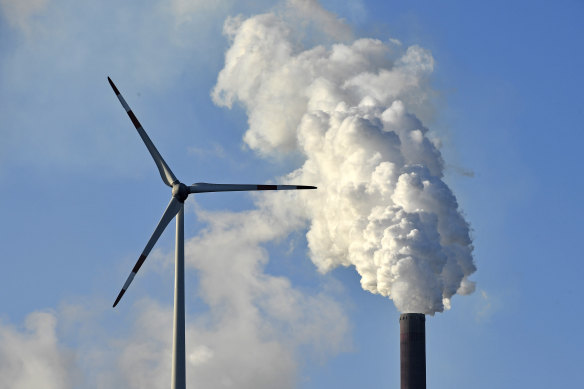Strung out: Power line problems put nation’s renewable rollout on backburner
By Mike Foley and Nick Toscano
Major delays to the expansion of Australia’s outdated east-coast power grid are stalling the nation’s renewable energy growth, raising the likelihood that polluting coal-fired power stations will keep running beyond their scheduled closure dates.
The lack of power lines, exacerbated by years-long delays to major projects, has emerged as a roadblock to the clean energy shift by stifling the flow of power from far-flung wind and solar farms, hydroelectric dams and batteries to major cities.

Blowouts for key transmission lines is risking further extensions to operation of coal plants and increased greenhouse emissions from the energy grid. Credit: AP
Energy system experts said delays to power grid upgrades made it more likely that coal-fired power stations Yallourn in Victoria and Eraring in NSW may need to be extended beyond their expected closures in 2028 and 2027. Both plants are already receiving support from state governments to ensure they do not close prematurely.
Grattan Institute senior fellow Tony Wood said the mounting list of delays, rather than any one project, was leading to the predictions of Australia using coal for longer.
“We’ve now got a forecast that says … we better make sure we’ve got enough insurance. It’s not as though one of the delays individually leads to a catastrophic conclusion, but each one of them contributes,” Wood said.
Matt Rennie, executive director of energy consultancy Rennie Advisory, said electricity demand was increasing, driven by factors ranging from population growth, households switching from gas to electric appliances, and the emergence of power-hungry data storage centres.
Fresh delays revealed last week on VNI West – a planned 240-kilometre transmission line between the Victorian and NSW grid – increased the likelihood that Yallourn would be used beyond its current life expectancy, he said.
“In a situation where demand is growing quickly, and supply is constrained through an absence of transmission lines, I refuse to believe that people would willingly close something down that could be so profitable in that situation,” Rennie said.
“When you’ve got a functioning coal plant in an environment of increasing demand, pulling supply out just doesn’t seem to make economic sense to me.”
A spokesperson for the plant’s owner, EnergyAustralia, said the company was committed to closing Yallourn in 2028.
The completion date for the $3.3 billion VNI West transmission line has blown out from 2028 to 2030; the EnergyConnect link between South Australia, Victoria, and NSW has been delayed from 2026 to 2027 – the cost has also blown out from $2.3 billion to $4.1 billion; and the expected completion of Marinus Link from Tasmania to the mainland has grown from 2030 to 2032.
Unless the delays are addressed, experts say, the consequences could be severe: energy reliability will come under pressure as electricity demand outpaces supply, while wholesale prices will become more volatile – tumbling during the day when it’s sunny before spiking in the evenings when solar recedes and the grid must call on expensive gas-fired generation to plug gaps.
Rennie said if EnergyAustralia pressed ahead with Yallourn’s scheduled closure date in 2028, he expected another investor would snap it up.
“When you’ve got a coal-fired power station that’s been closed early in a situation where you’ve got the sort of pressures we’re seeing, I just can’t help but think that there’s a better owner for that than EnergyAustralia,” he said.
State and federal governments are committed to reaching net zero emissions by 2050. The Albanese government has set a target to raise the proportion of renewable energy in the electricity grid from its current level of 40 per cent to 82 per cent by 2030.
Electrical Trades Union national secretary Michael Wright said governments must reform planning and approvals processes to achieve their goals.
“Fixing project planning and approvals so they work better for workers and their communities as well as industry and the national economy should be a major priority for government,” Wright said.
University of NSW senior researcher Dylan McConnell said while the VNI West delay in particular was a headache for the renewable rollout, it should be viewed in the wider context of a 15-year energy transition.
“It’s not great if you are a renewable energy developer who wants to connect [to the grid] in that part of the world. You might have to put the brakes on, or slow down a bit in the very short term, but I’m not entirely sure it’s a huge problem overall.”
A Victorian government spokesperson said the delay to VNI West would not slow the state’s energy transition, nor would it require the Yallourn coal plant to run beyond its 2028 closure date.
“The agreement with EnergyAustralia is to close Yallourn in 2028, and that plan has not changed … We have more than enough renewable energy capacity in the pipeline to replace Yallourn,” the spokesperson said.
Start the day with a summary of the day’s most important and interesting stories, analysis and insights. Sign up for our Morning Edition newsletter.